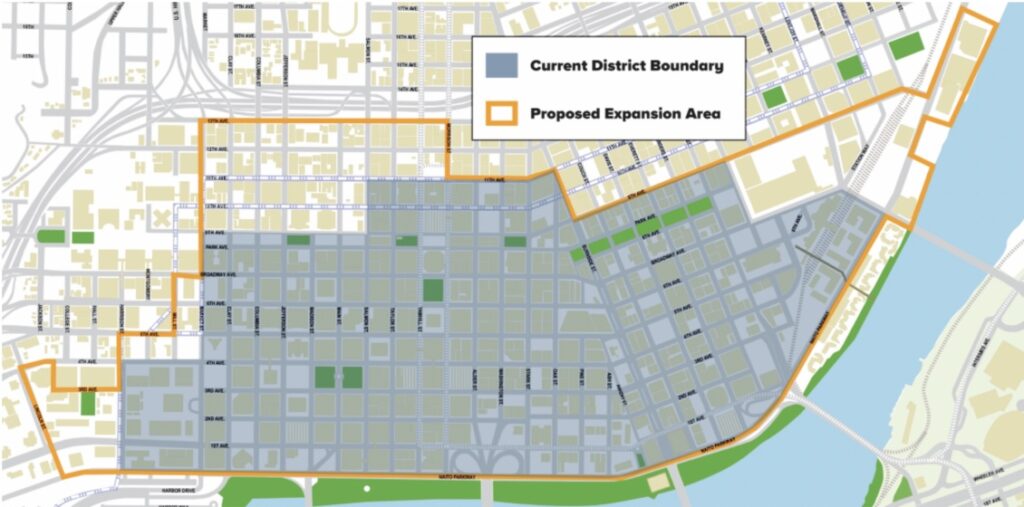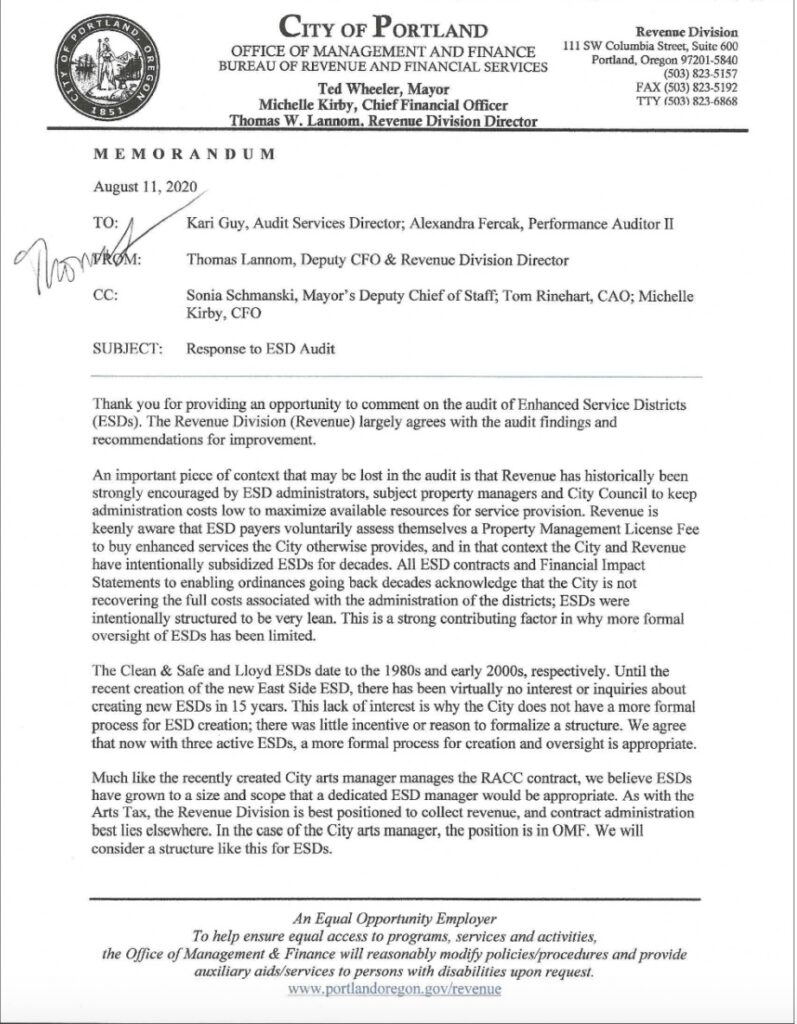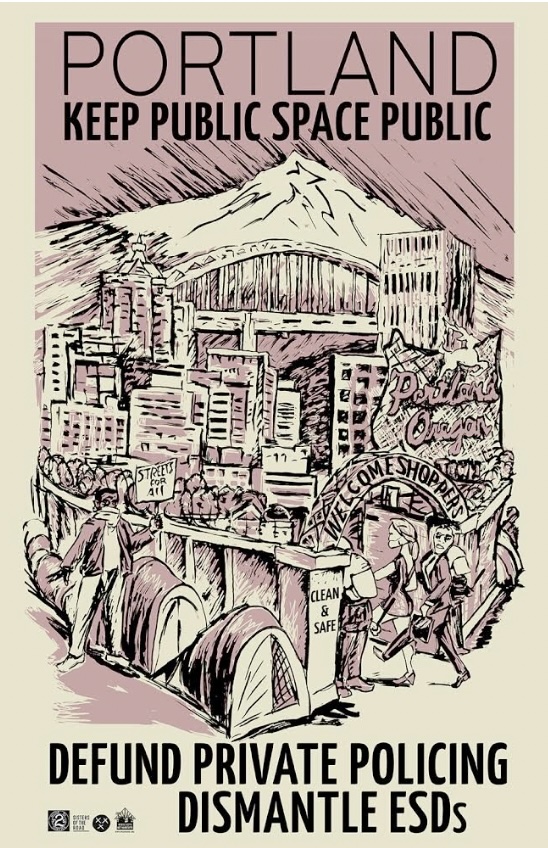In October 2024, the City of Portland announced the expansion of the Downtown Portland Clean & Safe Enhanced Service District (ESD). The benefits, according to its website, include “sidewalk and graffiti cleaning, a public safety team, street outreach support, holiday lighting and resources for managing property damage” in the included areas. The district expansion, not effective until October 2025, will include Northwest Academy’s campus.
Clean & Safe was originally founded in 1988 as a loose collective of businesses in downtown Portland and later formalized into city code in 1991. It is the oldest of Portland’s three ESDs which include Central Eastside Together and Lloyd ESD. These districts provide services outside of what the city offers and are financed by a mandatory fee paid by property owners in their respective areas. The Clean & Safe ESD is managed by a nonprofit called Downtown Clean & Safe, which contracts outside nonprofits and organizations, such as Integrated Avian Solutions, GardaWorld and Central City Concern, to provide their services. Downtown Portland Clean & Safe aims to “keep downtown a place we’re all proud of,” according to its website.
Though the effort to expand the affected Clean & Safe area was already underway, Brock Dunn, Interim Head of School, and Inge Hoogerhuis, Director of Admissions, helped finalize the school’s inclusion in the expansion.
“As the community evolves, so do the challenges in maintaining the health and safety of this vital area,” Dunn said in an address to city council. “As of late we have observed increasing concerns related to public safety, cleanliness and access to resources, all of which impact the quality of life for our students, but also for our neighbors who live and do business here.”
Public restrooms, showers and trash cans are few and far between in downtown Portland, so bio and physical hazards are common on sidewalks and streets. Northwest Academy is no stranger to these issues as its campus is adjacent to a needle exchange and houseless encampments.

“We’re making sure we’re creating the safest environment we can for our students,” said Hoogerhuis. “I think [Clean & Safe is] helping the whole city understand the dilemmas and the opportunities [we have] to create change. There will be more emphasis on creating place and space. Graffiti removal and garbage cans are the things that Clean & Safe will actually add to our area.”
Some downtown nonprofits like the Blanchet House are in support of the work Clean & Safe has done. Blanchet House, a local organization founded in 1952, offers resources like meals, clothing and jobs to houseless people, as well as helping them transition off of living on the streets.
Scott Kerman, Executive Director of Blanchet House and former Interim Head of School at NWA, believes that Clean & Safe services are a valuable asset to his nonprofit’s efforts. Working in tandem, he thinks the two organizations are able to provide resources to the houseless population and keep Portland’s streets clean.
“In our experience, the Clean & Safe program — particularly its partnership with Central City Concern — provides a significant benefit to the cleanliness and livability of Portland and opportunities for individuals to re-enter the workforce and build stability toward future job opportunities,” said Kerman. “At Blanchet House, we emphasize serving with dignity. This includes providing a clean outside environment for people accessing our services, free of litter and especially biohazards. Clean & Safe and other crews help us meet this objective.”
Beth Burns is the Executive Director and Co-Founder of p:ear, another organization working to increase employment, educational and enrichment opportunities for Portland’s houseless community. p:ear has collaborated closely with Clean & Safe to ensure their downtown office is ready to receive the community they serve.
“We are very much indebted to Clean & Safe,” said Burns. “They are really important [in the] maintenance and care of our outside space. They not only have both provided meaningful jobs and pathways for young people that I know [but are] also on the ready when we call to come help make our space outside clean and healing.”
Clean & Safe reports high success rates in downtown including increased foot traffic since the pandemic but a report by the Portland City Auditor found that the program had very little city oversight even though it’s officially led by the Portland City Council. This resulted in low management and accountability for the spending of city funds. The City of Portland’s Revenue Service has been placed in charge of overseeing Clean & Safe in totality, including both financials and provided services. The audit finds that while the ESDs are submitting revenue reports, the Revenue Office is not collecting or reviewing them, violating the contract. Some information consisting of subcontracts, audits, budgets and district functions were never collected by the city.
“The auditor said it lacked accountability and transparency, because ratepayers cannot go to the meetings,” said Anita Davidson, a condominium owner in the Clean & Safe district. “The city requires us to pay, gives them the money and never checks on what’s happening.”
The City of Portland Office of Management and Finance Bureau of Financial Services responded to the audit in a short letter, in an attempt to justify their lack of oversight, while acknowledging their shortcomings that the audit revealed.
“An important piece of context that may be lost in the audit is that Revenue has historically been
strongly encouraged by ESD administrators, subject property managers and City Council to keep administration costs low [and] to maximize available resources for service provision,” said Thomas Lannom, Deputy CFO & Revenue Division Director, in the letter (see below). “[…] We agree that now with three active ESDs, a more formal process for creation and oversight is appropriate.”

But the negative sentiment continues to proliferate among owners of downtown properties, as the city has not made these changes in the two years since the audit.
“We are not allowed to see who votes on what, we are not allowed to see the agenda,” said Davidson. “We’re totally excluded from it.”
Davidson thinks that the money taken in by Clean & Safe could be spent more effectively. She believes Clean & Safe should supply a higher level of service, because what Clean & Safe offers are “basic government services,” and should be provided by the city.
This system is similar to many other cities, which have Business Improvement Districts run through a multitude of private organizations. But these organizations have strict oversight by the cities they work within, according to the local governments of Los Angeles and New York City.
“The efficiency of the program is not good,” said Davidson. “Why can’t we just pay the city, [and] the city can have a contract with Central City Concern directly? There are so many middle men, there is so much waste and inefficiency.”
Further, Davidson said the program doesn’t benefit her, or her fellow condo owners. She said that her HOA performs much of the program’s services.
“We have experienced a lot of downsides,” said Davidson. “Our property values are lower than they were 10 years ago, downtown is still suffering. What Clean & Safe is doing is not improving our lives.”
The Pigeon Press contacted Portland’s 12 city councilors to understand why the services Clean & Safe offers aren’t provided by the city and funded with tax dollars. Eric Zimmerman represents Portland’s downtown and upper west side up through District Four. He didn’t respond to our email but Luke Zak, Community Relations Manager and Policy Advisor of Zimmerman’s office did.
“In brief, to answer your questions,” said Zak, “an ESD is established to expand upon basic City services already provided citywide to add vibrancy, maintain cleanliness, improve safety, assist with business development, engage in marketing and improve transportation. They are, however, not funded through taxes.”
Zak was one of only a few to respond to our multiple email attempts. More often were received no answer, an automatic reply, or as in Zimmerman’s case, a response not from him but from someone in his office but Councilor Tiffany Koyoma Lane of District Three was the exception.
“The City’s role is to collect a property management license fee,” said Koyoma Lane, “which pays for the district’s “enhanced services”…your question as to whether this is a nonprofit’s job is an excellent one, and one I think we should be asking as we move into our new form of government.”
Beyond the frustration from business and homeowners, critics of the Clean & Safe program are further concerned with its ties to the Portland Business Alliance (PBA). PBA is a division of the Portland Chamber of Commerce, and its members include businesses such as Nike, Google and Amazon.
“They lobby for their members, and their members are businesses,” said Davidson. “We as ratepayers are paying something to support the Chamber of Commerce.”
Being left out of the discussion leads to even more concern among property and business owners. Tax dollars get funneled through the PBA before being sent to districts and then contractors, while the PBA takes an unknown cut out of these public funds.
A portion of the money Clean & Safe makes goes to paying the salaries of its board members. Many PBA executives are also on the board of Clean & Safe. 45% of PBA and Downtown Clean & Safe CEO Andrew Hoan’s salary, $333,030 as of 2023, comes from its revenue.
“Is [Andrew Hoan] spending his time at City Hall glad-handing in support of small businesses, or is he just advocating for the interests of big businesses that are part of PBA?” asked an anonymous employee of a nature conservation organization.
Many are uneasy about where the program’s money is going, due to the unknown portion that goes to lobbying and PBA members’ salaries. All Clean & Safe board members are members of the PBA.
“A lot of public entities pay into Clean & Safe, so we have public entities paying into a private organization that lobbies them to do things that are not in the interest of the public,” the anonymous source continued.
Public organizations such as Multnomah County and the City of Portland, Portland State University and Portland Community College are required to pay into the program. In 2022, 16.47% of Clean & Safe revenue came from public entities.
“The police department pays, the library pays, the art museum will pay,” said Davidson. “About 20% of the money paid into Clean & Safe is public money already. They say [they’re] just business taxing [themselves] to provide these services, but that is not true.”
Another prominent criticism of Clean & Safe is its treatment of houseless people. Of particular concern to advocates for the unhoused are the private security which Clean & Safe contracts, some of whom are armed. The organization only recently repealed their agreement with police, in which they paid officers to patrol their districts.
“Private security is really just an extended branch of the police to hyper-surveil people who have to live very public lives, including people who are homeless,” said Lauren Armony, the Systemic Change Director at Sisters of the Road, a nonprofit organization that supports the unhoused community.

Property owners in the ESD can call security if they have a perceived issue with an unhoused person. Clean & Safe contracts the private security company GardaWorld, who provide “personnel protection, crowd control and surveillance technology,” according to their website. Armony believes that calling private security is often overkill.
“Most of the calls they get are nuisance calls, what nuisance is is wildly subjective,” said Armony. “A lot of people do not know that the ESD exists, but they do know that security tells them to move.”
Sisters of the Road, like all non-profits in the ESD, is required to pay Clean & Safe’s fee. All property owners in the ESD are required to pay, regardless of whether they support or express an interest in the program. “We’ve been inside this ESD since its inception, and our community members are severely impacted by their policies,” said Armony. “We are paying into these districts with our tax dollars, and we have zero influence in what they do with those dollars.”
Armony is the creator of End Clean & Safe, a website and campaign against the program, with the slogan “keep public space public.” She says that the program amounts to privatization of spaces that should be public.
“They are making it incredibly uncomfortable to be here, with constant surveillance and a lack of comfortable urban design,” said Armony. “They’re trying to create a hostile place where you have to pay money to be here unless you already live here.”
End Clean & Safe campaigned unsuccessfully to stop the expansion of the ESD. Armony says they will continue their public records requests and efforts to raise awareness about how the money is spent.
“Another funny one is the crow hazing,” said Armony. “People really don’t like crow poop, so they hire hawks to move crows around. That is part of why the crow is kind of the mascot of the End Clean & Safe campaign, because how they are dealing with these crows is how they are dealing with people.”
Clean & Safe contracts Integrated Avian Solutions, a bird abatement company, to chase crows out of the downtown area with trained hawks. Their 2024 contract said that over $60,000 of their revenue per year is spent on crow abatement. Also according to their contract, the effectiveness of the crow abatement program is evaluated annually by the ESD Coordinator.
For some, despite the program’s controversial spending habits, the success of the Clean & Safe prevails. This is the case for Dunn who, despite his confusion around funding for the service, continues to advocate for its positive impact on downtown Portland.
“Whether we like how it’s being funded or the political nature of things, we could take a walk around town and chart the Clean & Safe boundary,” Dunn said. “It’s that obvious. To keep our business viable, I want to be inside that boundary.”
The Pigeon Press attempted to contact Clean & Safe directly, but the organization declined to make a statement.
Reporting by The Pigeon Press staff
